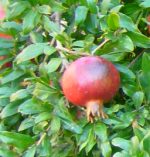 A native Iran and Iraq, the pomegranate is a deciduous tree or shrub that has been grown since ancient times and is widely cultivated for the juicy seeds of its fruit in warm dry areas of Asia, Middle East, Africa, Europe, and South America. Growing up to 33′ tall the plants have fine-textured, glossy green leaves that are opposite, narrow oblong, and 1.25-2.75″ long. From mid spring to the beginning of summer, showy red-orange flowers are borne singly or in clusters of up to five. Each flower is up to 1.25″ across and has 3-7 petals . In the fall, the foliage takes on a reddish or bright yellow tint as the large almost spherical fruits appear. The fruits are 2 to 4″ across and have a tough, leathery, pink to red skin and an interior divided into hundreds of segments by thick, cream-colored membranes. The segments are filled with a seed surrounded by a sac of tart juice. The plants are are extremely long-lived, up to 200 years old, and are grown as ornamentals as well as for fruit. Pomgranate is a member of the loostrife family, Lythraceae, that also includes crepe myrtle, henna, and Cuphea. The genus name, Punica, is the Latin word for Carthaginian, an ancient civilization in the Africa. The specific epithet, granatum, is the Latin word meaning having many seeds.
A native Iran and Iraq, the pomegranate is a deciduous tree or shrub that has been grown since ancient times and is widely cultivated for the juicy seeds of its fruit in warm dry areas of Asia, Middle East, Africa, Europe, and South America. Growing up to 33′ tall the plants have fine-textured, glossy green leaves that are opposite, narrow oblong, and 1.25-2.75″ long. From mid spring to the beginning of summer, showy red-orange flowers are borne singly or in clusters of up to five. Each flower is up to 1.25″ across and has 3-7 petals . In the fall, the foliage takes on a reddish or bright yellow tint as the large almost spherical fruits appear. The fruits are 2 to 4″ across and have a tough, leathery, pink to red skin and an interior divided into hundreds of segments by thick, cream-colored membranes. The segments are filled with a seed surrounded by a sac of tart juice. The plants are are extremely long-lived, up to 200 years old, and are grown as ornamentals as well as for fruit. Pomgranate is a member of the loostrife family, Lythraceae, that also includes crepe myrtle, henna, and Cuphea. The genus name, Punica, is the Latin word for Carthaginian, an ancient civilization in the Africa. The specific epithet, granatum, is the Latin word meaning having many seeds.
granatum leaves are opposite or subopposite, glossy, narrow oblong, entire, 3–7 cm (1+1⁄4–2+3⁄4 in) long and 2 cm (3⁄4 in) broad. The flowers are bright red and 3 cm (1+1⁄4 in) in diameter, with three to seven petals.[4] Some fruitless varieties are grown for the flowers alone.[10]
Type: Deciduous tree or shrub
Outstanding Feature: Fruit, flowers
Form: Vase-like
Growth Rate: Moderate
Bloom: Single or clusters of orange-red flowers in late spring to early summer
Plant Size: 10-33’H x 8-15’ W
Light: Full sun
Soil: Deep loam, medium moist, well-drained, pH 6.5-7 but tolerate less; drought tolerant
Fertilizer: In late winter or early sprig apply a complete fertilizer such as 16-4-8
Hardiness: Zones 7-11 (but may not produce fruit in colder areas)
Care: Can be pruned to produce a single or multiple trunks by pruning suckers accordingly. Once established, prune lightly to maintain shape and remove suckers, damaged stems and to open the canopy. For maximum fruit production, remove small fruits leaving one on every 6-8” of stem.
Pests and Diseases: Leafrollers, aphids, citrus flat mite, leaf-footed bug, Alternaria fruit rot, Aspergillus fruit rot, and gray mold
Propagation: Seed; hardwood cuttings; air layering of suckers, grafting
Outstanding Selections: Over 500 cultivars are avaialbe

-
- ‘Wonderful’ (extra large fruit, juicy and sharp flavor, ripens in September)

- ‘Grenada” (more colorful than ‘Wonderful’).
